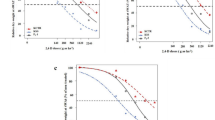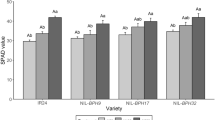Abstract
The BASF Corporation recently developed Provisia™ rice that is resistant to the ACCase inhibitor quizalofop-p-ethyl (QPE) for control of grassy weeds and that is complementary to the existing Clearfield® technology. The objective of this research was to determine the inheritance of resistance to QPE in different populations of rice evaluated under laboratory and greenhouse conditions. Five QPE-resistant lines and 13 susceptible U.S. varieties and breeding lines were used to develop 16 F1 populations that showed dominant gene control for QPE resistance in the greenhouse. Germinating seeds and young seedlings from 16 F2 and 12 BC1F1 populations, along with corresponding susceptible and resistant parents, were exposed to minimum lethal concentrations of QPE. The results indicated that resistance to QPE under the two environments was governed by a single dominant Mendelian gene with no observable maternal effects. Allele-specific SNP markers for QPE resistance were developed that also followed Mendelian segregation in four F2 and six BC1F1 populations. Results from this study have direct implications for breeding strategies of inbred and hybrids varieties resistant to QPE in the laboratory and greenhouse and for effective stewardship of the Provisia™ technology.


Similar content being viewed by others
Abbreviations
- PCR:
-
Polymerase chain reaction
- QPE:
-
Quizalofop-p-ethyl
- SNP:
-
Single nucleotide polymorphism
References
Ausubel FM (2003) SNAP Program. https://ausubellab.mgh.harvard.edu. Accessed 10 Oct 2018
BASF (2017a) Get the Most Out of Every Clearfield® Rice Acre. http://www.horizonseed.com/horizon/pdf/variety-downloads/BASF-2017-CL-Rice-Stewardship-Guidelines.pdf. Accessed 10 Oct 2018
BASF (2017b) BASF introduces the Provisia™ Rice System. https://www.basf.com/us/en/company/news-and-media/news-releases/2017/05/P-US-17-054.html. Accessed 10 Oct 2018
BASF (2017c) Provisia Herbicide. http://www.assets.greenbook.net/19-25-53-23-02-2017-Provisia_NVA_2017-04-522-0004.pdf. Accessed 10 Oct 2018
Blanche SB, Linscombe SD, Sha XY, Bearb KF, Groth DE, White LM, Harrell D (2009) Registration of ‘Catahoula’ rice. J Plant Reg 3:146–149
Bzour MI, Zuki FM, Mispan MS (2018) Introduction of imidazolinone herbicide and Clearfield® rice between weedy rice—control efficiency and environmental concerns. Environ Rev 26(2):181–198
Croughan, TP (2015) Resistance to acetohydroxyacid synthase-inhibiting herbicides. US Patent 9,090,904
Delouche JC, Burgos NR, Gealy DR, Zorrilla G, Labrada R (2007) Weedy rice: origin, biology, ecology and control. Vol. 188. Food and Agriculture Organization. 6-9
Délye C, Zhang XQ, Michel S, Matéjicek A, Powles SB (2005) Molecular bases for sensitivity to acetyl-coenzyme A carboxylase inhibitors in black-grass. Plant Phys 137:794–806
Linscombe SD (2017) Provisia™ Rice Will be Valuable for the Louisiana Rice Industry. LSU AgCenter. http://www.lsuagcenter.com/profiles/vdartez/articles/page1505744457923. Accessed 10 Oct 2018
Linscombe SD, Jodari F, Bollich PK, Groth DE, White LM, Chu QR, Dunand RT, Sanders DE (2000) Registration of ‘Cocodrie’ Rice. Crop Sci 40:294
Linscombe SD, Sha XY, Bearb KF, Chu QR, Groth DE, White LM, Dunand RT, Bollich PK (2006) Registration of ‘Cheniere’ rice. Crop Sci 46:1814–1815
Mankin S, Schofl U, Hong HP, Wenck A, Neuteboom L, Whitt S, Carlson DR (2014) Herbicide-tolerant plants. US Patent 20140045686
Oard JH, Harrell DL, Groth DE, Bearb KF, White LM, Linscombe SD (2014a) Registration of ‘Mermentau’ Rice. J Plant Reg 8:135–138
Oard JH, Harrell DL, Groth DE, Bearb KF, White LM, Linscombe SD (2014b) Registration of ‘CL111’rice. J Plant Reg 8:5–8
Oard JH, Harrell DL, Groth DE, Bearb KF, White LM, Linscombe SD (2014c) Registration of ‘CL152’rice. J Plant Reg 8(1):9–12
Romero LE, Lozano I, Garavito A, Carabali SJ, Triana M, Villareal N, Reyes L, Duque MC, Martinez CP, Calvert L, Lorieux M (2014) Major QTLs control resistance to rice hoja blanca virus and its vector Tagosodes orizicolus. Genes Genomes Genet 4(1):133–142
Smith RJ Jr (1988) Weed thresholds in southern US rice, Oryza sativa. Weed Technol 2:232–241
Tan S, Evans RR, Dahmer ML, Singh BK, Shaner DL (2005) Imidazolinone-tolerant crops: history, current status and future. Pest Manag Sci 61(3):246–257
Zhang WQ, Linscombe SD, Webster E, Tan SY, Oard JH (2006) Risk assessment of the transfer of imazethapyr herbicide tolerance from Clearfield® rice to red rice (Oryza sativa). Euphytica 152:75–86
Acknowledgements
Research supported in part by the Louisiana Rice Research Board and the USDA-NIFA.
Author information
Authors and Affiliations
Corresponding author
Ethics declarations
Conflict of interest
The authors declare that there is no conflict of interest.
Additional information
Publisher's Note
Springer Nature remains neutral with regard to jurisdictional claims in published maps and institutional affiliations.
Rights and permissions
About this article
Cite this article
Camacho, J.R., Linscombe, S.D., Sanabria, Y. et al. Inheritance of Provisia™ rice resistance to quizalofop-p-ethyl under laboratory and greenhouse environments. Euphytica 215, 83 (2019). https://doi.org/10.1007/s10681-019-2407-4
Received:
Accepted:
Published:
DOI: https://doi.org/10.1007/s10681-019-2407-4




